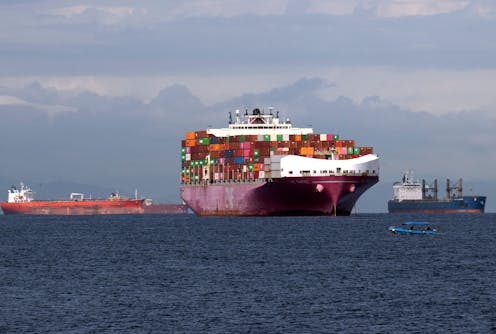Fresh water is a hidden challenge − and opportunity − for global supply chains
- Written by Dustin Cole, Assistant Professor of Supply Chain Management, Auburn University

Reports of lengthy shipping delays[1] for vessels traveling through the Panama Canal this year have highlighted the critical but often overlooked role that fresh water plays across global supply chains. Drier than normal conditions in Panama, brought on by El Niño, have left the region drought-stricken[2] and water levels in the locks that feed the canal lower than normal. This has led to fewer ships being able to pass through the canal each day: only 31 ships[3] currently, compared with 36 to 38 under normal conditions. This means longer waits to move products through the canal and onto store shelves.
The slowdown at the Panama Canal shows how access to fresh water is key to the way goods are made and shipped, affecting everything[4] from the price of groceries to retail forecasts for the upcoming holiday shopping season. As a professor of supply chain management[5], I think businesses would be wise to pay closer attention to this issue.
But first, you might ask: What does fresh water have to do with ocean freight? Plenty, it turns out.
Water, water everywhere, and not enough to share
The Panama Canal is a freshwater connection between two oceans – not a saltwater link, as one might assume. A series of locks on each side of the canal raise cargo freighters nearly 100 feet to human-made lakes that extend across Panama’s isthmus and lower them down to sea level on the other side.
Each crossing by a ship requires 52 million gallons[6] of fresh water from lakes, rivers and streams across this small country. This creates a trade-off between preserving water for local needs and using it to allow ships to traverse the canal. Less water allocated to the canal means fewer ships can pass through.
This isn’t an isolated phenomenon. Periodic low water levels in the Mississippi River[7] and the Rhine River[8] in Germany have impeded barge traffic for years, disrupting supply chains while stoking debate about how to divide limited amounts of fresh water. Recent plans by communities in northern Colorado to build their own reservoirs[9] on tributaries of the Colorado River highlight questions about who owns access to local waterways and how this resource is governed.
An ancient challenge
The need to manage water resources isn’t new, with complex water management systems dating back to the Roman Empire[10] and even earlier[11]. Humankind has made great progress on water management over the centuries, but in recent years the issue has often taken a back seat to other pressing environmental concerns such as global warming.
Water management is complicated by the fact that businesses and communities sometimes find themselves in conflict: Businesses want to use water for their operations, while communities want to preserve water supplies to ensure that residents’ basic needs are met. At the same time, communities also need the jobs and services that businesses provide. Examples such as the Panama Canal highlight this tension.
Balancing these seemingly contrary needs calls for a deeper look into how much water is used in the making of products people buy and use every day.
As my colleagues and I show in a recent journal article, water is an important component[12] of almost everything people buy. For example, roughly 2,600 gallons of water[13] goes into making the fabric for a single pair of jeans. From growing cotton for the fibers needed to manufacturing the denim and getting those jeans onto shelves at The Gap, more and more water is embedded into each pair as it moves through the supply chain.
Essentially, businesses use water to transport water embedded in virtually all products they sell. This is why businesses have more than purely altruistic reasons to address water-related problems: It isn’t just good for society but also their own operations. A lack of water can hamper production and disrupt the supply chains that businesses rely on.
Inside the world’s largest cargo shipping bottleneck. | WSJ.Solutions for businesses
There are a number of ways in which businesses can improve their water management to reduce their own consumption – and costs – while limiting their exposure to water risks.
First, companies should realize that not everything requires clean water. Wastewater from one process can be used for another that doesn’t require clean water. Similarly, not every process pollutes water, so reuse is easy for wastewater resulting from those processes, such as water used for cooling.
Second, firms can share wastewater between facilities for reuse, a concept called industrial ecology[14]. For example, nutrient-rich water from food production can be used for farm irrigation rather than being discharged.
And third, since water is an excellent medium for heat transfer, rather than trying to cool one area and heat another, companies can connect the systems. For example, global aluminum giant Novelis is deploying hot water used in the casting process at one of its plants in Europe to heat a neighboring building[15].
Opportunities abound for improving management of fresh water – one of our most precious resources. While stronger government regulations and expanded reporting requirements will help, decisions by businesses themselves can move that needle even more.
For those who do, their standing in the communities in which they operate will surely benefit – as will their bottom lines.
References
- ^ lengthy shipping delays (www.nytimes.com)
- ^ left the region drought-stricken (www.bbc.com)
- ^ 31 ships (apnews.com)
- ^ affecting everything (www.cnn.com)
- ^ professor of supply chain management (harbert.auburn.edu)
- ^ 52 million gallons (1997-2001.state.gov)
- ^ Mississippi River (www.wsj.com)
- ^ Rhine River (www.reuters.com)
- ^ build their own reservoirs (insideclimatenews.org)
- ^ dating back to the Roman Empire (education.nationalgeographic.org)
- ^ even earlier (eal.isas.illinois.edu)
- ^ water is an important component (doi.org)
- ^ 2,600 gallons of water (interestingengineering.com)
- ^ industrial ecology (www.sciencedirect.com)
- ^ heat a neighboring building (www.novelis.com)







